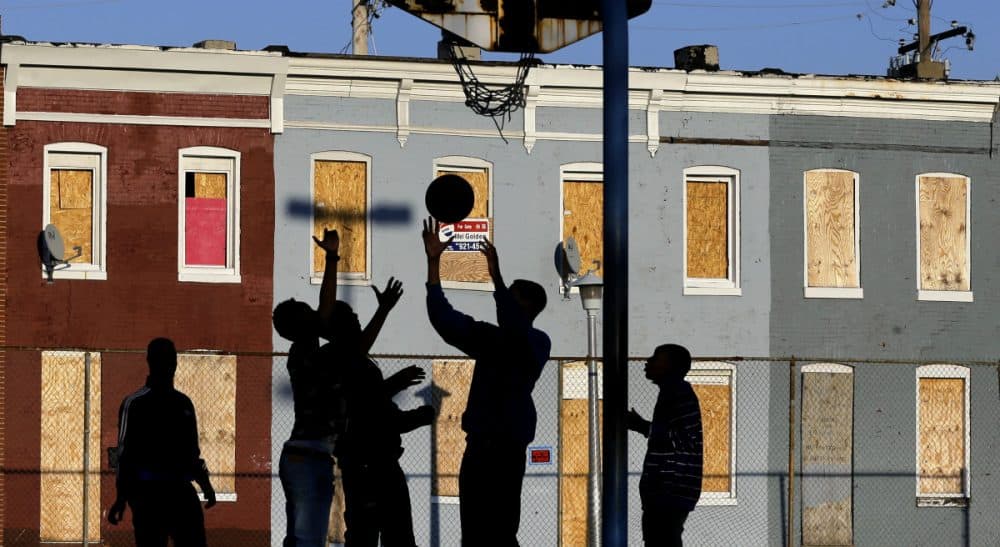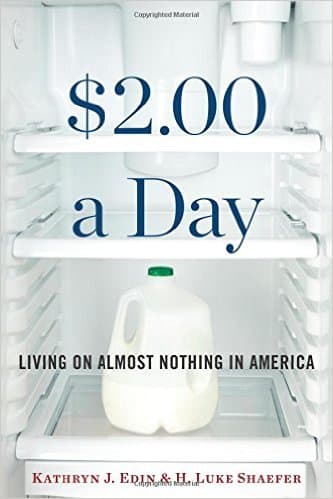Advertisement
Millions Are Living On $2 A Day — Yes, In The United States

Every year the U.S. Census conducts a household survey with a long list of detailed questions intended to determine, among other things, how well government support services are reaching needy families. In 2011, social scientists Kathryn J. Edin and H. Luke Shaefer made a stunning discovery while trolling through this data: More than 4 percent of all households with children in the United States have so little cash income that it amounts to less than $2 per person a day.
Such extreme poverty is usually associated with developing nations, where $2 a day is a standard measurement used by the World Bank. Indeed, the 4 percent level would put the U.S. about on par with Thailand, according to an analysis by the Brookings Institution, and Thailand is poor enough to be a recipient of U.S. foreign aid.
the number of virtually cashless families in America has doubled in the last 15 years.
Of course, the data aren’t perfect, and certain caveats apply. For example, a large percentage of these families received food stamps or other non-cash assistance. But food stamps can’t be used to pay the light bill or the rent. The shocking fact of these families and the complex strategies they use to survive is a national disgrace — a reality that is unseen by most Americans and largely unheard in the presidential debate.
Worse, the toll is rising. In a new book, “$2.00 a day: Living on Almost Nothing in America," Edin and Shaefer show that the number of virtually cashless families in America has doubled in the last 15 years. The Census figures are reinforced by other indicators, including a sharp increase in demand for food pantries and homeless shelter beds. “These findings seem to confirm the rise of a new kind of poverty,” they write.

Sheer numbers can’t begin to describe the struggle of these families. So Edin, a professor at Johns Hopkins University, and Shaefer, of the University of Michigan School of Social Work, spent three years following eight families from Cleveland, Chicago and small communities in Mississippi and Tennessee. They expected the $2 a day adults would be completely disconnected from the world of work. But most had some job history, albeit unsteady and poorly paid. One woman went from being a two-time “cashier of the month” at a Cleveland Walmart to fired when her slim hold on reliable transportation collapsed. The families fell in and out of their $2 a day status based on whether the adults could find jobs. In an interview this week, Shaefer described them as living on “the ragged end of the labor market.”
The strategies people in extreme poverty use to survive are inventive — and exhausting. They collect bottles for their deposits, trade part of their food stamp allotment for cash, barter for necessities, sell their few possessions and sometimes their bodies. One particularly chilling indicator of the rise in extreme poverty is the spike in the number of blood plasma donations. Shaefer and others have found that plasma donations — which typically pay subjects about $30 per donation — rose from 12 million in 2006 to 23 million in 2011. One of the women profiled in the book — a 21-year-old mother from Tennessee the authors call Jessica -- donates plasma up to 10 times a month, as frequently as the law allows. She makes sure to eat a protein bar and bring a calming book to read so her blood pressure will be low and her blood iron high enough to be acceptable.
Advertisement
The world these two professors describe is a lens on changes in the entire U.S. economy over the last few decades: the decline of union-backed manufacturing jobs; the growing wage gap; the unstable, unpredictable hourly work that is patched in when an employer sees fit; the decline of government subsidies for housing and cash assistance.
These findings seem to confirm the rise of a new kind of poverty.
The authors say their findings are an indictment of the welfare “reform” law signed by President Clinton in 1996. Although they do not advocate a return to the old Aid to Families with Dependent Children system, the shorter time limits and other strictures on welfare benefits have reduced those eligible for cash support by 69 percent to 4 million people — 3 million of them children. Instead, public assistance has shifted to the Earned Income Tax Credit, which is a great boon to the working poor but no help to those without a job.
For all its harrowing descriptions of life in extreme poverty, “$2.00 a day” is also a reminder that government interventions can make a profound difference. Food stamps, for example, reduce the number of families living on $2 a day by 48 percent. An increase in the minimum wage and legislation to improve job security and worker’s rights would also help.
This sobering book is really a call to action. “The families living on $2 a day haven’t given up,” says Shaefer, “so it’s not acceptable for us to throw up our hands.”
